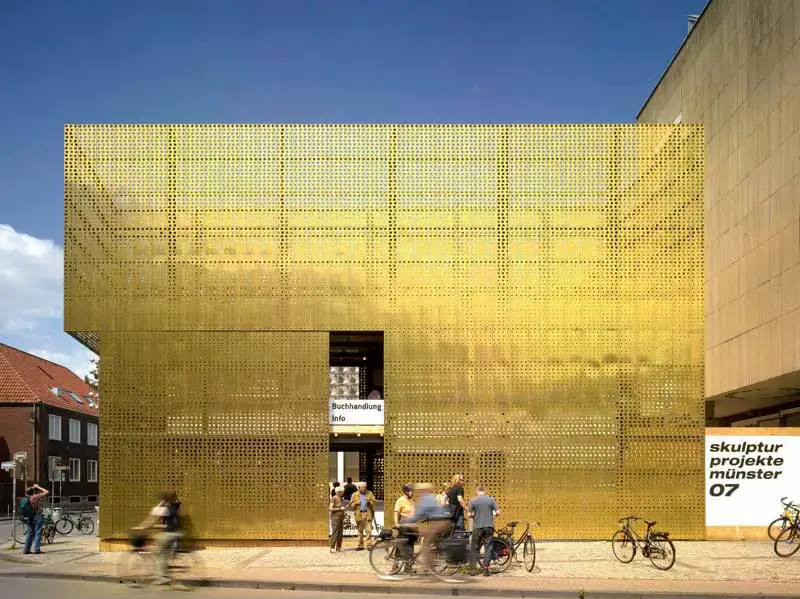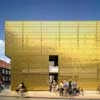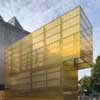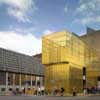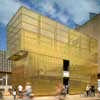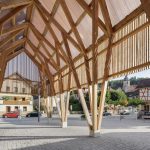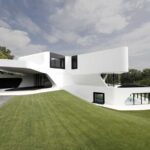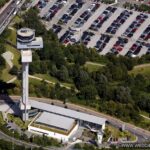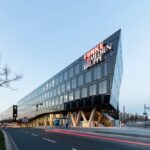Skulptur Projekte Münster Building Images, Germany gold architecture design photo
Skulptur Projekte Münster
German building by modulorbeat Architects
2 Jan 2008
Golden Architecture in City Sculpture Park, 2007
Issuer: KME Germany AG; Editor: Klaus Sikora, s-works
TECU Architecture Prize 2007: 1st Prize C
Münster Building
Golden Architecture in City Sculpture Park
A temporary construction project has been specially created to mark the occasion of the internationally renowned outdoor exhibition Skulptur Projekte Münster 07. The construction has an excellent relationship to its surroundings and to this extraordinary event.
The switch+ information centre, which will serve its purpose for the duration of the 106-day art project, has already attracted a great deal of attention during the opening days. Impressively clad in its shining gold perforated façade made of new copper alloy TECU® Gold, the construction provokes an irresistible urge to have a closer look and discover its very special spatial and aesthetic features.
From 17 June to 30 September 2007, the art event Skulptur Projekte Münster, held every ten years, is taking place for the fourth time. In contrast to its larger neighbour, documenta XII, one of the most important art exhibitions worldwide and taking place at the same time only 200 kilometres away in the central German town of Kassel, this younger project in the city of Münster – increasingly popular in the art scene – exclusively features projects set in public space that have an intense relationship to the local surroundings.
Whereas in Kassel, temporary spaces – which themselves invariably draw varying degrees of controversy – are created for the works of art presented, Münster hosts most sculptures as temporary installations in the midst of a relatively permanent, well-established urban environment. In this way, many of the 36 artists participating in the exhibition engage in clear, exciting communication on the subject of space, city and architecture: Hans-Peter Feldmann necessitated the renovation of public toilets at the Domplatz. Guillaume Bijl staged an excavation site and had a typical German church steeple protrude from a deep hole in the ground; Bruce Nauman has sunken an upside down pyramid in the ground, finally realizing his project from 1977 which was, back then, not approved by local building authorities. These projects have attracted the attention of an ever-increasing public. The project managers expect a record 500,000 visitors this year.
As a model for thoroughly successful temporary architecture, the switch+ information pavilion lucidly illustrates the urban focus of Skulptur Projekte Münster 07. Planned and supervised by Münster firm modularbeat, a twelve meter high parallelepiped, which is clad on all sides with the new copper alloy TECU® Gold, was built adjacent to the Museum of Art and Cultural History and the exhibition project office on an open square that has been unused up to now. The project makes interesting references to its direct surroundings and its own function. The golden surface takes on the colour of the writing designed by artist Martin Schmidl for Skulptur Projekte Münster 07, that is decorating the façade of a building close to the pavilon and marking the location of the exhibition project office. With colour, materials and its evenly distributed round perforations of varying diameter, the building also reacts to the light installation Silver Frequency created by the artist Otto Piene in the 1970’s for the museum façade across the way.
The function of the switch+ pavilion is revealed by examining its name: The eastern side of the lower half of the façade, facing the street corner, rests on slide rollers and can be moved so that entrances on both sides of the information centre close or open. In this way, various “switch settings” emerge as recommendations for pedestrians passing by, that, when open, invite them to the southern entrance and the information stand. On the other side, visitors are guided to the north entrance over a jagged landscape – part of the overall design of the public square – consisting of varying heights and irregularly arranged steps and levels, all made out of plywood. The bookshop on the mid-level is accessible from the entrance on the west side, located higher up and leading to the rooftop terrace café on the top floor via a wooden staircase. Seen from the inside, the frame of the pavilion appears as a simple steel grid construction, onto which the TECU® Gold cassettes are directly fastened without a substructure.
The floors are made of plywood boards on battens. With the exception of the bookshop, which is protected from wind and weather on all sides by tarpaulins of the kind otherwise used for trucks, all areas are separated from the outside world alone by the perforated metal skin. This creates fascinating views. Particularly in the evening, when the pavilon seems to glow due to the interior lighting and a soft shimmer is cast through the perforations, a wonderful play of light and space is created in combination with the activated light installation on the museum façade, even more fascinating regarding the fact that this Piene work is so urgently in need of renovation. The reactions to this pavilion and its golden cladding, which draws all eyes upwards and is so very unusual for Münster’s usual cityscape, are numerous: Passers-by photograph the object as often as the sculptures on display, touch the pleasantly smooth surface in disbelief, caress the perforations as if they were looking for an explanation for the impressive façade image.
Children from the neighbouring summer academy romp over the wooden stair landscape between the pavilion and museum, blow bubbles in the air and, unbeknownst to them, add an additional design element to the façade image across the way – spontaneous city planning without a long-term concept. Several visitors to the café seem angered at plans to dismantle the “most beautiful sun terrace in the town centre” after 106 days. But the object shares its fate with most of the other art works on display. After 30 September, the dismantling begins. The “golden” façade components return to their manufacturer KME Germany in Osnabrück, where they will be recycled for further use. However, some small pieces of the facade will be kept as mementos: Several of the disks cut out in the perforation process and embossed Skulptur Projekte Münster 07 will be available for sale to the public.
The directors of the modulorbeat firm, Marc Günnewig and Jan Kampshoff have made a name for themselves with various activities in the area of city construction culture, city planning and architecture in Münster. Already during their studies in the relatively new Master of Art and Architecture degree programme, they organized presentations on the subject at student parties. Later designs for specific spaces followed, which made the organizers of Skulptur Projekte Münster, among others, take notice of their firm. As local contributors were sought for the preparations of the current sculpture exhibition, modulorbeat came up with their design which received immediate approval.
Since gold was an essential component of this design, TECU® Gold finally proved to be the perfect material. The new copper-aluminium alloy, one of many copper materials under the brand name TECU® made by KME proved to have unique advantages for this project: an unmistakable, beautiful surface, extreme durability, easy processing. Thanks to support from KME as well as the BSW construction company in Everswinkel, who converted the drawings of the individual perforated façade elements for use in a CAD system and took on the press cut and fold of individual TECU® Gold plates, nothing more stood in the way of the technical realisation of switch+. Thanks to financial support for this ambitious project by the city planning commission of North Rhine-Westphalia, the project also received a sound financial base.
Switch+ is, amazingly, the first architecture project implemented by modulorbeat up to now. Considering the attention-getting value of the project, the renown of the event Skulptur Projekte Münster 07 and the general positive reception they have earned, it can safely be assumed that it won’t be their last. The beat goes on.
switch + Münster – Building Information
Object: switch +, info-pavillon for the Skulptur Projekte Münster 07 exhibition
Planning/Realisation: modulorbeat, Marc Günnewig and Jan Kampshoff, Münster
Completion: Jun 2007
Dismantling: Sep 2007
Façade material: TECU® Gold, Copper-aluminium alloy
Manufacturer: KME Germany AG
Perforation: BSW Anlagenbau, Everswinkel (D)
Processing in construction: rückwerk, Münster
Skulptur Projekte Münster info from s-works 020108

photo from KME Awards (Disk issue) 2007
Skulptur Projekte Münster 07 exhibition architects : modulorbeat
Location: Münster, Germany, western Europe
Architecture in Germany
German Architecture
German Architectural Designs – chronological list
Golden Workshop Münster
modulorbeat Architects
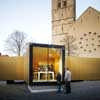
image © Christian Richters
Golden Workshop Münster
Temporary Pavilion that was on display in Münster for the exhibition “Golden Glory. Medieval Treasury Art in Westphalia”, a small, attractive pavilion containing a gold workshop as well as an information point.
Jewish Museum Berlin
Daniel Libeskind Architect
Jewish Museum Building
Müritzeum
Wingårdh Arkitektkontor AB
Müritzeum
German museum building : Folkwang Museum, Essen
Hotel & Spa Seezeitlodge, Lake Bostalsee
Design: GRAFT
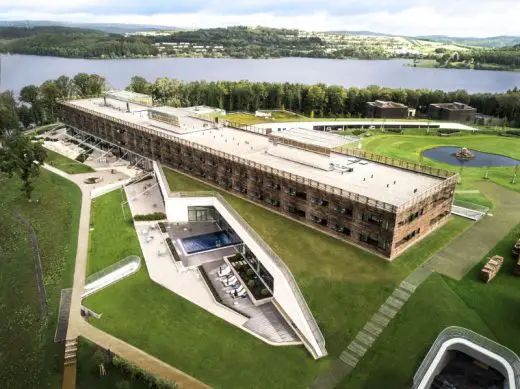
photograph : Airteam
Hotel & Spa Seezeitlodge, Lake Bostalsee
Comments / photos for the Skulptur Projekte Münster building page welcome

